Redexim Turf-Stripper 1200 Owner's manual
- Type
- Owner's manual

User Manual and Parts
Book
Turf-Stripper
Model 1200
Serial number:
Translation of original operating
instructions
Kwekerijweg 8
3709JA Zeist
The Netherlands
Tel.: (31)306933227
Fax: (31)306933228
Email: verti-drain@redexim.com
www.redexim.com
ATTENTION:
IT IS OF THE UTMOST IMPORTANCE TO READ THIS USER MANUAL
CAREFULLY PRIOR TO USING THE TURF-STRIPPER IN ORDER TO USE THE
MACHINE SAFELY AND TO OBTAIN THE BEST RESULTS.
1702 English 953.120.000

2
FOREWORD
Congratulations on your Turf-Stripper purchase! For safe and long-lasting operation of this
Turf-Stripper, it is necessary to read and to understand this user manual.
It is impossible to work safely with this machine without complete knowledge of the content of
the user manual.
The Turf-Stripper is not a machine that works independently. It is the user’s responsibility to
use the correct tractor. The user must also check the tractor/Turf-Stripper combination on
safety aspects such as noise level, user instructions and risk analysis.
The following pages deal initially with the general safety instructions. Every user should know
these safety instructions and apply them. At the end of this page, a registration card is
inserted. This registration card should be returned to enable us to deal with potential future
claims.
This user manual lists many instructions that are numbered in sequence. You should follow
this sequence. A is an indication of a safety instruction. A means a tip and/or
note.
All information and technical specifications provided at the moment that this document is
published are the most recent ones. Design specifications may be changed without prior
notice.
This document is a translation of the original operating instructions.
Upon request, the original operating instructions are available in Dutch.
WARRANTY CONDITIONS
WITH DELIVERY THIS TURF-STRIPPER IS GUARANTEED AGAINST MATERIAL
DEFECTS.
THIS WARRANTY IS VALID FOR A PERIOD OF 12 MONTHS FROM THE PURCHASE
DATE.
TURF-STRIPPER WARRANTIES ARE SUBJECT TO THE ‘GENERAL CONDITIONS FOR
SUPPLY OF PLANT AND MACHINERY FOR EXPORT, NUMBER 188’ THAT ARE
PUBLISHED UNDER THE AUSPICES OF THE UNITED NATIONS ECONOMIC
COMMISSION FOR EUROPE.
REGISTRATION CARD
For your own information, fill in the table below:
Serial number of the
machine
Dealer name
Date of purchase
Remarks

3
! SAFETY INSTRUCTIONS !
Figure 1
The Turf-Stripper is designed for safe use. This
can only be achieved if you completely follow the
safety instructions described in this manual.
Read and understand (figure 1) the manual
before you use the Easy Spread.
If the machine is not used as described in this
manual, this can result in injuries and/or damage
to the Turf-Stripper.
1. The user must be an expert in using the machine. The machine should be
professionally adjusted for cultivating the subsoil.
The manufacturer will not accept any liability for unprofessional use and its resulting
damage. All risks occurring with this are entirely at the expense of the user.
Following the use, maintenance and repair instructions prescribed by the
manufacturer is also considered professional use of this machine.
Inspect the area to be treated before using the Turf-Stripper.
Remove loose obstacles and avoid irregularities.
2. The Turf-Stripper is manufactured according to the latest technical
understanding and is safe to use.
When unskilled people use, maintain or repair the machine, this could result in
injuries to the user and to third parties. This must be avoided!
Always use the Turf-Stripper in combination with the correct tractor as described in
the technical data.
3. All persons assigned to operate, maintain and repair the Turf-Stripper by the
owner must completely read and understand the operation manual and in
particular the chapter of Safety Instructions.
The user is responsible for a safe Tractor / Turf-Stripper combination. This entire
combination must be tested for noise, safety, risk and user friendliness. User
instructions should also be drafted.
4. The user is obliged to check the Turf-Stripper for visible damage and
defects before using the Turf-Stripper.
Modifications to the Turf-Stripper (including its operations) that have a negative
impact on safety must be rectified immediately.
For safety reasons it is in principle not permitted to make changes or adjustments to
the Turf-Stripper (except those approved by the manufacturer).
If modifications to the Turf-Stripper have been made, then the current CE marking is
cancelled. The person that has made these modifications has to apply for a new CE
marking himself.

4
Check the Turf-Stripper for loose bolts, nuts and components before every operation.
If present, check the hydraulic pipelines regularly and replace these when the
hydraulic pipelines are damaged or appear old. The pipelines that are replaced
should comply with the technical requirements of the manufacturer.
If a hydraulic installation is present, you should always make it pressure-free before
working on this installation.
NEVER use the Turf-Stripper in the absence of the safety stickers.
NEVER crawl under the Turf-Stripper.
If necessary, tilt the Turf-Stripper.
NEVER step off the tractor while the motor is running.
In case of maintenance, adjusting and repairs, it is necessary to block the Turf-
Stripper in order to prevent sinking away, driving off and/or sliding off.
Always switch off the tractor motor, take the tractor’s key out off the ignition
and disconnect the PTO in case of maintenance, adjusting and repairs. (Fig.2)
Figure 2
With regards to the safety of the machine and the user, use only original Turf-Stripper
parts for maintenance and repairs.
Only authorised technical personnel may carry out repairs to the Turf-Stripper.
Keep a record of the repair activities.
5. The general applicable health & safety (Dutch: ARBO) regulations must also
be followed in addition to the instructions in this user manual.
Relevant traffic regulations also apply in case of using public roads.
Transporting persons is not permitted!
Do not use the Turf-Stripper in the dark, in heavy rain/storm or on slopes with an
angle larger than 20 degrees.
6. All persons that are going to operate the Turf-Stripper must be familiar with all
the functions and control elements of the Turf-Stripper before starting any
work activities.
Attach the Turf-Stripper to the towing vehicle according to the regulations.
(Danger of injuries!)

5
Check whether you have a clear field of vision – both close by and far away – before
you depart.
Safety stickers with an identical meaning are attached to the rear cover (Figure 5 and 6)
and to both sides (Figure 2, 3 and 4) of the Turf-Stripper. These safety stickers must
always be clearly visible and legible and must be replaced if they have become
damaged.
During operation, NO persons without the proper protection gear are allowed
within the danger zone of the Turf-Stripper, because there is danger of physical
injuries caused by flying particles or substances (Figure 3).
Figure 3
Figure 4
Keep a distance of minimum 4 metres! (Figure 4)
The rear cover must always be closed and undamaged while operating the
machine! (Figure 5)
BE CAREFUL not to get any parts of your body jammed! (Figure 6)
Figure 5
Figure 6
Pay attention to the permitted lifting capacity of the towing vehicle.
Dress appropriately. Wear sturdy shoes with steel toecaps, long trousers and tie up
long hair. Do not wear loose clothing.
Use the proper personal protection gear according to the applicable health & safety
(Dutch acronym: ARBO) and safety regulations.

6
7. Location of the Turf-Stripper 1200 safety stickers (Figure 7).
Used oil / grease is harmful to the environment. Dispose of these substances
according to the regulations that apply in your location.
Figure 7

7
EU DECLARATION
We – Redexim BV, Utrechtseweg 127, 3702 AC Zeist, Holland – declare entirely under
our own responsibility that the product:
TURF-STRIPPER WITH A MACHINE NUMBER AS INDICATED ON THE MACHINE AND
INDICATED IN THIS MANUAL
to which this declaration refers, complies with stipulation of the 2006/42/EC machine
directive and is in conformity with the following standards: NEN-EN-ISO 12100 : 2010 NEN-
EN-ISO 13857 : 2008
Zeist, 28.07.2014
A.C. Bos
Manager Operations & Logistics
Redexim Holland

8
TABLE OF CONTENTS
WARRANTY CONDITIONS ....................................................................................... 2
REGISTRATION CARD ............................................................................................. 2
! SAFETY INSTRUCTIONS ! ................................................................................. 3
EU DECLARATION ................................................................................................... 7
1. TECHNICAL DATA ......................................................................................... 9
2. GENERAL DESCRIPTION .............................................................................. 9
3. FIRST INSTALLATION – TAKING THE MACHINE OFF THE PALLET ........10
4. ATTACHING THE MACHINE TO THE TRACTOR ........................................11
5. THE POWER TAKE-OFF (PTO) ....................................................................12
5.1 LENGTH OF THE PTO .......................................................................................................................... 12
5.2 USING THE PTO ................................................................................................................................... 13
6. MOUNTING THE CUTTER KNIVES ..............................................................13
7. ADJUSTING THE WORKING DEPTH ...........................................................14
8. TRANSPORTING THE TURF-STRIPPER .....................................................15
9. DRIVING SPEED ............................................................................................15
10. USING THE TURF-STRIPPER .......................................................................15
11. START/STOP PROCEDURE .........................................................................16
12. DETACHING THE TURF-STRIPPER .............................................................17
13. TROUBLE SHOOTING (PROBLEM ANALYSIS) ..........................................18
14. MAINTENANCE .............................................................................................19
14.1 LUBRICATING POINTS .................................................................................................................. 20
14.2 ADJUSTING THE TENSION OF THE V-BELTS ............................................................................ 21
14.3 CONVEYOR BELT ALIGNMENT .................................................................................................. 22
15. OPTIONAL: SCARIFYING KNIVES ...............................................................23

9
1. TECHNICAL DATA
Working width
1.2m (47.2”)
Working depth
Up to 50mm (2”)
Drain height
Up to 1,500mm (59.1”)
Working speed
The working speed depends on the conditions and the required
result. It is maximum 3 km/h (1.8 mph).
Weight in kg
620 kg (1367 lbs)
Three-point connection
Cat. 1
Gearbox oil to be used
SAE 140
Bearing grease to be used
EP2
Recommended tractor
30 -40 HP
Minimum lift capacity of
the tractor (24”) from the
lifting balls
775 kg (1709 lbs)
Hydraulic connections of
the tractor
1x double-operating valve
PTO revs
540 rpm
Standard items
PTO
Cutter knives
Optional
Scarifying knives
2. GENERAL DESCRIPTION
The Turf-Stripper is a processing machine for cutting or scarifying the grass field and
transporting the cut or aerated material.

10
3. FIRST INSTALLATION – TAKING THE MACHINE OFF THE
PALLET
The machine is placed vertically on the pallet. To remove the pallet and to place the machine
horizontally on the ground, take the following steps (see Figure 8):
!! NEVER CRAWL UNDER THE MACHINE !!
1. Attach a cable to the lifting eyes on both sides of the machine.
Make sure that the cable/crane/lift can hoist minimum twice the weight of
the machine. (See Chapter 1.0 ‘Technical Data’ for the weight details.)
2. Lift the machine including the pallet of approx. 50 mm (2”) off the ground.
3. Remove the pallet by removing the three-point pins A.
!! NEVER crawl under the machine !!
4. Slowly lower the machine until it touches the ground.
!! Attention: the machine can swing dangerously !!
5. Attach the machine to a tractor. (See Chapter 4.0 for instructions abolt
attaching to the tractor.)
Use the proper tractor (please refer to the specifications).
Turn off the tractor and secure the tractor / Turf-Stripper combination
against driving off and/or sliding off.
Figure 8

11
4. ATTACHING THE MACHINE TO THE TRACTOR
Checking procedure before starting to attach the Turf-Stripper.
Check the Turf-Stripper for visually discernible damage and
repair this if safe operation of the machine is no longer
guaranteed.
Check whether all the nuts and bolts are tight.
Check whether all safety stickers are present on the machine
and are not damaged.
NEVER use the machine without these items.
Figure 9
The Turf-Stripper can be attached to the tractor by means of the 3-point attachment.
The procedure is as follows: (Figure 9)
1. Remove the 3-point pins (1 and 2).
2. Drive the tractor carefully backwards so that the lower connecting arms can
be attached to the frame.
!! Make sure that the tractor is blocked well and cannot move on its own
accord !!
!! Switch off the tractor before descending !!
3. Connect the lower connecting arms to the 3-point connecting plates using the
pins (1) and secure these with the supplied locking pins.
4. Set the stabilizer of the tractor to 100 mm lateral stroke.
5. Connect the top rod (3) to the frame with the pin (2); secure the pin (2) with
the supplied locking pin.
!! Use Float Position 4 for towing while operating the Turf-Stripper and
Fixed Position 5 for transport !!
!! Make sure that all the fastening pins are locked !!
6. Turn the top rod (3) until the Turf-Stripper stands horizontally on the ground.
7. Attach the PTO to the Turf-Stripper.
8. Attach the hydraulic hoses of the Turf-Stripper to the tractor.
9. Start the tractor and lift the Turf-Stripper off the subsoil.

12
5. THE POWER TAKE-OFF (PTO)
The PTO is a very important component. It also takes care of safe use of the machine,
provided it is installed and maintained in the correct manner. The PTO has its own CE
certification. Read the PTO manual. This manual is located on the PTO.
Figure 10
5.1 LENGTH OF THE PTO
The length of the PTO is very important. If it is too long, it can damage the drive of the tractor
and/or the Turf-Stripper. If the overlapping length of the cylinders becoKnife less than 150
mm (6”) at any time, it can damage the PTO.
The length changes when the machine is lifted or when a different
tractor is used!
In order to set the PTO to the correct length, when a new one has been purchased or when a
different tractor is used, follow these steps: (see Figure 10)
1. Measure the distance between the PTO’s connection to the tractor and to the Turf-
Stripper, from groove to groove, when the machine is connected to the tractor and
positioned on the ground at the right angle.
2. Measure the distance B of the PTO in its shortest position from the locking pin to the
locking bolt.
3. Divide the PTO in two parts and remove the protection cap at both ends.
4. The ends of the cylinders and the ends of the protection caps must be made shorter:
(B-A) + 75 mm (3”).
5. Smooth off all components, use some grease, and then assemble all components.
6. Mount the PTO on the side of the Turf-Stripper.
7. Attach the other end of the PTO to the tractor.
8. Check the overlap of the cylinders.
Never use the machine if it has a damaged PTO protection cap. First
replace any damaged parts!

13
5.2 USING THE PTO
The following items must be checked for correct use of the PTO:
1. While working the angle of the pivot pins may not exceed 30 degrees.
2. The pivot pins of the PTO on the tractor and on the machine must always be
aligned.
3. The overlap of the cylinders must always be minimum 150 mm.
4. Never use the machine if it has a damaged PTO protection cap.
5. For lubrication, please refer to Chapter 12.0 ‘Maintenance’.
6. MOUNTING THE CUTTER KNIVES
Knives pointing to the left-hand side are mounted on all discs A (except for disc B). Knives
pointing to the right-hand side are mounted on disc B (see Figure 10a).
Figure 10a

14
7. ADJUSTING THE WORKING DEPTH
Figure 11
The working depth is set by adjusting the front roller.
The rear roller must be set to the long groove (A) for cutting and scarifying.
Adjusting:
1. Adjust the rear spindles (2) to the correct position. For this purpose, use the
indicator (see Figure 11) and block it by tightening the lock nut.
2. Adjust the front spindles (1) at both sides of the machine until the required
working depth is achieved and block it by tightening the lock nut.
3. Check the working depth by operating the machine on a few metres.
If necessary, readjust the working depth.
If the transport belt is folded out, the machine weight shifts to this side. Due to
the extra mass of the material that need to be transported, more material can
be removed at this side. You can compensate this by turning spindles (1) and
(2) in order to set the machine to less depth at this side .

15
8. TRANSPORTING THE TURF-STRIPPER
The user is responsible for transporting the Turf-Stripper in back of the tractor over public
roads. Verify the national legislation regarding the regulations.
On open fields while the machine is raised and if circumstances allow this, the maximum
permitted speed is 12 km/h (8 mph) due to the weight of the Turf-Stripper.
A higher speed can be dangerous for the driver and/or the public and can even damage the
machine.
Make sure that the uppermost top rod is attached and is pressurized in the
transport position (position 5)! See Chapter 4.0, figure 9.
If this is not done, the machine can incur serious damage.
!! Attention: the transport belt has to be tipped up !!
When the machine is raised off the ground, the front axle of the tractor has to
support minimum 20% of its weight.
9. DRIVING SPEED
The driving speed depends on the conditions and the required result. It is maximum 3 km/h
(1.8 mph).
It is NOT recommended to drive faster due to the fact that excessive wear & tear and
damage can occur to the machine and to the subsoil.
10. USING THE TURF-STRIPPER
Before using the Turf-Stripper in a location, you should check the following items:
1. Are there loose objects in the field? First remove these objects.
2. Are there slopes? The maximum slope is 20 degrees for this machine.
3. Always go from top to bottom.
4. Is there danger of flying objects (e.g., balls) that distract the attention of
the driver? If so, the Turf-Stripper CANNOT be used.
5. Is there danger of sinking/sliding away? If so, postpone the processing
until conditions improve.
6. Are there hard objects in the ground? If so, use the Turf-Stripper with a
low PTO speed and, if necessary, adjust the working depth.
7. If the soil is very wet, postpone the activities until conditions improve.

16
11. START/STOP PROCEDURE
The start procedure is VERY important. If this procedure is not executed as described below,
it might result in serious damage to the machine.
The start procedure is as follows:
1. Check the Turf-Stripper for loose components and look whether all components
function properly.
!! If loose components are observed or components do not function
properly, the problems must be solved before using the Turf-Stripper !!
2. Drive to the spot where the processing should take place.
!! Attention: the transport belt has to be tipped up !!
3. Lower the machine onto the ground.
4. Fold the transport belt outward.
!! Make sure that the tractor is blocked well and cannot move on its own
accord !!
!! Switch off the tractor before descending !!
5. Adjust the working depth as described in Chapter 7.0.
6. If required, the top rod can be placed in the slotted hole (4) in the land-tracking
position (see Chapter 4.0, figure 9).
7. Raise the Turf-Stripper slightly so that the knives just don’t touch the ground and
engage the tractor in the proper gear.
8. Activate the hydraulic outlet of the tractor in order to let the transport belts turn.
9. Adjust the tractor engine to around 1200 rpm and engage the PTO.
10. Slowly lower the machine until it reaches the required working depth.
11. Drive forwards and increase the rotational speed until the PTO rotational speed of
540 rpm is achieved.
12. For the first track:
Check whether the required working depth is achieved. If necessary, adjust the working
depth as described in Chapter 7.0.
Stopping occurs as follows:
1. Decrease the engine revs to approx. 1200 rpm.
2. Lift the machine slightly off the ground.
3. Switch the PTO off as soon as the knives no longer touch the subsoil.
4. Close the hydraulic outlet of the tractor (used for operating the transport belts).
5. Fold the transport belt inward.
6. Lift the machine even more.
7. Go to the next location and start again as described above.

17
12. DETACHING THE TURF-STRIPPER
Figure 12
The machine can be detached from the tractor in the following manner (See Figure 12):
1. Drive the Turf-Stripper to a parking area with a firm/flat surface.
!! Make sure that the tractor is blocked well and cannot move on its own
accord !!
!! Switch off the tractor before descending !!
!! Attention: the transport belt has to be tipped up !!
2. Adjust the height of the rollers so that the knives stand above the ground (see
Chapter 7.0).
3. Lower the machine onto the ground.
4. Make sure that the machine cannot move on its own accord by blocking the
rear roller.
5. Remove the hydraulic hoses.
6. Remove the top rod (3).
7. Loosen the PTO at the side of the tractor.
8. Disconnect the lower connecting arms of the tractor.
!! Make sure that the Turf-Stripper stands stable and cannot roll away
and/or slide off !!
9. Start the tractor and drive off.

18
13. TROUBLE SHOOTING (PROBLEM ANALYSIS)
Problem
Possible cause
Solution
Machine vibrates.
- Obstacle(s) between the
knives
- Worn or broken knives.
- Rotor is off-balance.
- Remove the obstacle(s).
- Replace with new knives.
- Balance the rotor.
Working depth is not
achieved.
- Working depth is not adjusted
correctly.
- Subsoil is too hard.
- Driving speed is too high.
- Adjust the working depth
properly.
- Lower the driving speed or
pass over the soil more than
once.
- Lower the driving speed.
Too coarse processing
of the soil
- Driving speed is too high.
- Subsoil is too wet.
- Decrease the driving speed.
- Wait for better conditions.
Rotor is jammed.
- Subsoil is too wet.
- Obstacle(s) between the
knives
- Driving speed is too high.
- Too much overgrowth
- Wait for better conditions.
- Remove the obstacle(s).
- Decrease the driving speed.
- Cut the overgrowth.
Rotor does not turn.
- The V-belts that drive the rotor
slip.
- Machine is adjusted too deep.
- Pull the V-belts taut.
- Adjust the machine to less
depth.
Transport belt cannot
cope with the quantity
of material.
- Driving speed is too high.
- Transport belt turns too slowly.
- Lower the driving speed.
- Increase the oil flow of the
tractor.
Transport belt moves
slowly or does not move
- No hydraulic flow
- Transport belt slips
- Check hydraulic connections
- Tighten the transport belt

19
14. MAINTENANCE
Time schedule
Check / Grease point
Method
Before every use
- Check for loose bolts / nuts.
- Check the oil level in the
gearbox.
- Presence and readability of the
safety stickers
- Loose hanging parts around the
PTO
- Check for hydraulic defects.
- Check for cracks/defects in the
transport belts.
- Tighten loose bolts / nuts with
the correct tightening moment.
- Use SAE140.
- Replace these if not present or
damaged.
- Tighten the parts so that they
cannot reach the PTO.
- Repair or replace, if needed.
- Repair or replace, if needed.
After every use
- Clean the machine.
- Grease the rotor bearings.
- Watch out for the bearings if a
high-pressure sprayer is used.
- 1 shot EP2 (see Figure13)
After the first 20
working hours (new
or repaired)
- Lubricate the PTO and roller
bearings.
- Check for loose bolts / nuts.
- Check the oil level in the
gearbox.
- Check the gearbox for oil leaks.
- Loose hanging parts around the
PTO
- Check the tension of the V-
belts.
- Use EP2 grease
- Tighten loose bolts / nuts with
the correct tightening moment.
- Use SAE140.
- Repair the leaks / damaged
parts.
Replace the seals / sealing
paste.
- Tighten the parts so that they
cannot reach the PTO.
- If needed, adjust the tension
(see Section 13.2).
Every 50 working
hours
- Lubricate the PTO and bearings
of the machine.
- Check for loose bolts / nuts.
- Check the oil level in the
gearbox. It has to reach at least
the halfway mark of the gauge.
- Check the gearbox for oil leaks.
- Loose hanging parts around the
PTO
- Check the tension of the V-
belts.
- Use EP2 grease (see Figure
13)
- Tighten loose bolts / nuts with
the correct tightening moment.
- Use SAE140.
- Repair the leaks / damaged
parts.
Replace the seals / sealing
paste.
- Tighten the parts so that they
cannot reach the PTO.
- If needed, adjust the tension
(see Section 13.2).
After every 500
working hours
- Change the oil in the gearbox.
- Use SAE140.

20
14.1 LUBRICATING POINTS
Figure 13
Page is loading ...
Page is loading ...
Page is loading ...
Page is loading ...
Page is loading ...
Page is loading ...
-
 1
1
-
 2
2
-
 3
3
-
 4
4
-
 5
5
-
 6
6
-
 7
7
-
 8
8
-
 9
9
-
 10
10
-
 11
11
-
 12
12
-
 13
13
-
 14
14
-
 15
15
-
 16
16
-
 17
17
-
 18
18
-
 19
19
-
 20
20
-
 21
21
-
 22
22
-
 23
23
-
 24
24
-
 25
25
-
 26
26
Redexim Turf-Stripper 1200 Owner's manual
- Type
- Owner's manual
Ask a question and I''ll find the answer in the document
Finding information in a document is now easier with AI
Related papers
-
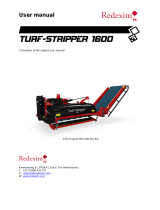 Redexim Turf-Stripper 1600 Owner's manual
Redexim Turf-Stripper 1600 Owner's manual
-
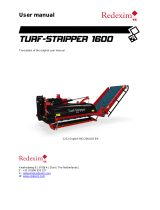 Redexim Turf-Stripper 1600 Owner's manual
Redexim Turf-Stripper 1600 Owner's manual
-
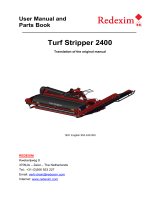 Redexim Turf-Stripper 2400 Owner's manual
Redexim Turf-Stripper 2400 Owner's manual
-
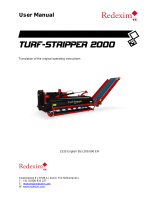 Redexim Turf-Stripper 2000 Owner's manual
Redexim Turf-Stripper 2000 Owner's manual
-
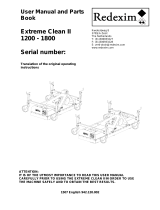 Redexim Extreme Clean 1200 Owner's manual
Redexim Extreme Clean 1200 Owner's manual
-
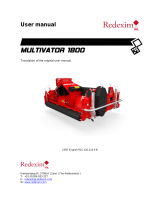 Redexim Multivator 1800 Owner's manual
Redexim Multivator 1800 Owner's manual
-
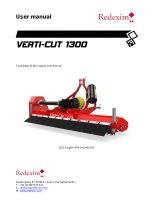 Redexim Verti-Cut® 1300 Owner's manual
Redexim Verti-Cut® 1300 Owner's manual
-
 Redexim Verti-Drain® 2220 Owner's manual
Redexim Verti-Drain® 2220 Owner's manual
-
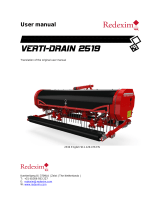 Redexim Verti-Drain® 2519 Owner's manual
Redexim Verti-Drain® 2519 Owner's manual
-
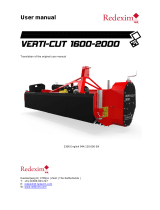 Redexim Verti-Cut® 1600 Owner's manual
Redexim Verti-Cut® 1600 Owner's manual
Other documents
-
Toro ProCore SR48 Aerator User manual
-
AGI Portable Drive-Over Belt Conveyer Owners & Operators Manual
-
Toro ProCore SR54 Aerator User manual
-
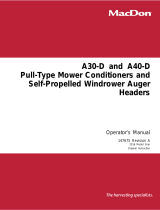 MacDon A30-D and A40-D User manual
MacDon A30-D and A40-D User manual
-
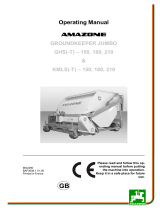 Amazone GHS JUMBO / KMLS Owner's manual
Amazone GHS JUMBO / KMLS Owner's manual
-
Servis-Rhino P/N 00763618C User manual
-
Ransomes 88120, 88121 Owner's manual
-
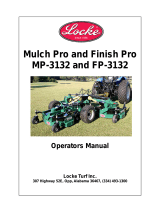 Locke Finish Pro FP-3132 User manual
Locke Finish Pro FP-3132 User manual
-
Locke TRM-3083 User manual
-
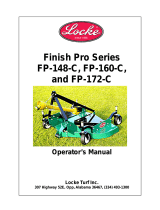 Locke FP-172-C User manual
Locke FP-172-C User manual







































